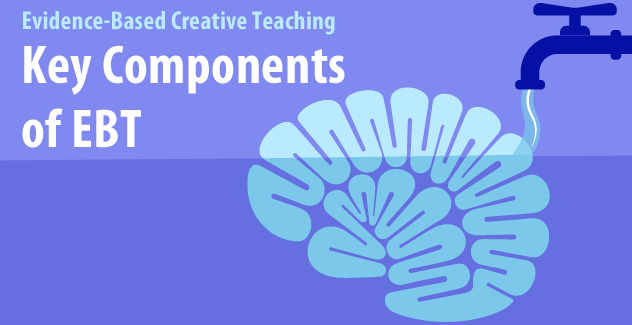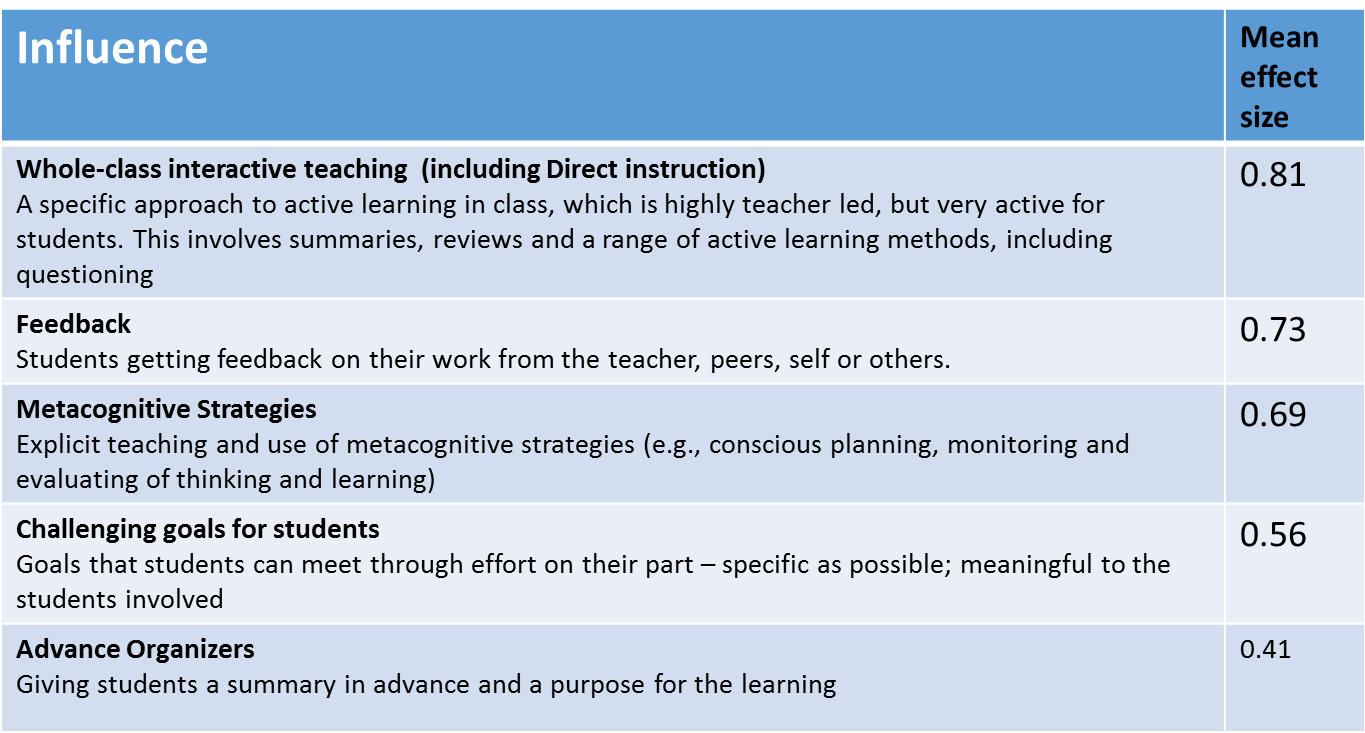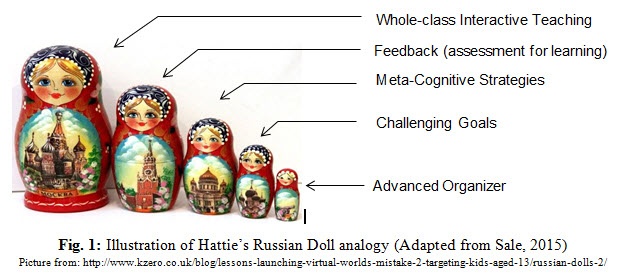
In the previous post, through some personal stories and research findings, I argued that good teaching is the most important aspect of quality in education. I then took you on a short tour in and out of Educational Jurassic Park—can you remember it?
In this second post I explain and illustrate the key components of Evidence-Based Teaching; what Petty (2009) referred to as a ‘Revolution in Teaching’.
Key Components of Evidence Based Teaching
In summary EBT is the evolution and synthesis of two related main strands of research over the past two decades:
- Understanding how people learn (e.g., Cognitive Scientific Principles) and applying this to the design and practices of teaching. Bransford (1999) and Willingham (2009) are notable pioneers in this area.
- Methods of teaching that work best (e.g., have high Effect Sizes in terms of impacting student attainment). The work of Hattie (2009; 2012) was a significant landmark here.
We have learned more about how the brain works in the last 20 years, than in the rest of human history, which is increasingly supporting what Willingham (2009) refers to as Cognitive Scientific Principles. These are universal ways in which the human brain takes in, processes and uses information to learn effectively. He uses an analogy with engineering:
Principles of physics do not prescribe for a civil engineer exactly how to build a bridge, but they do let him predict how it is likely to perform if he builds it. Similarly, cognitive scientific principles do not prescribe how to teach, but they can help you predict how much your students are likely to learn. If you follow these principles, you maximize the chances that your students will flourish. (p.165)
In ‘Creative Teaching: An Evidence-Based Approach’, I outlined and explained 10 cognitive scientific principles, which I referred to as the Core Principles of Learning:
- Motivational strategies are incorporated into the design of learning experiences
- Learning goals, objectives and proficiency expectations are clearly visible to learners
- Learners’ prior knowledge is activated and connected to new learning
- Learning is enhanced through multiple methods and presentation modes that engage the range of senses
- Content is organized around key concepts and principles that are fundamental to understanding the structure of a subject
- Good thinking promotes the building of understanding
- Learning design utilizes the working of memory systems
- The development of expertise requires deliberate practice
- Assessment is integrated into the learning design to provide quality feedback
- A psychological climate is created which is success orientated and fun.
These core principles of learning constitute a pedagogic framework from which teaching professionals can thoughtfully plan and facilitate learning experiences from an evidence-based perspective. They are not exhaustive or summative as new knowledge and insights will continually enhance our understanding of human learning and the implications for how we teach. However, from much validation in practice across a wide range of educational sectors and cultural contexts, I see them as contributing to a much-needed Pedagogic Literacy.
Furthermore, while each core principle of learning focuses attention on a key area or process relating to how humans learn and the specific implications for planning instruction, they are not discrete or separate in that they should be considered independently of each other. In fact, they are mutually supporting, interdependent and potentially highly synergistic. As Stigler & Hiebert (1999) highlighted:
Teaching is a system. It is not a loose mixture of individual features thrown together by the teacher. It works more like a machine, with the parts operating together and reinforcing one another, driving the vehicle forward. (p.75)
John Hattie and the Holy Grail of Teaching
Mansell’s (2008) article in Times Educational Supplement on 21 November referred to Hattie’s seminal work on the effectiveness of different teaching methods and strategies as:
… perhaps education’s equivalent to the search for the Holy Grail—or the answer to life, the universe and everything.
There is little doubt that Hattie’s work is a definitive landmark in educational research, as he synthesized over 800 meta-analyses of the influences on learning, identifying both what factors impacted learning, and the extent of their impact—referred to as Effect-Size. Effect-Size is a way to measure the effectiveness of a particular intervention to ascertain a measure of both the improvement (gain) in learner achievement for a group of learners and the variation of learner performances expressed on a standardised scale. Taking into account both improvement and variation it provides information as to which interventions are worth having.
Hattie firstly identified the typical effect sizes of schooling without specific interventions, for example, what gains in attainment are we likely to expect over a one-year academic cycle? Typically, for students moving from one year to the next, the average effect size across all students is 0.40. Hence, for Hattie, effect sizes above 0.40 are of particular interest. As a baseline an effect size of 1.00 is massive and is typically associated with:
- Advancing the learner’s achievement by one year
- Improving the rate of learning by 50%
- A two-grade leap in GCSE grades.
Two features of Hattie’s research are highlighted here. Firstly, his work revealed relative comparisons of intervention use, which enables us to go beyond identifying the effect sizes for specific innovations (deliberative intervention involving strategy/method use for a group of students), but also ascertaining whether the effects of a such innovations were better for students than what they would achieve if they had received alternative innovations. Table 1: Examples of High Effect Strategies/ Methods, shows some well-used strategies/methods that have high or positive Effect-Sizes

Table 1: Examples of High Effect Strategies/ Methods
Extracted form Hattie (2009) Visible Learning
Secondly, it is not just the effect size of one intervention that is important, but how a combination of effective methods can be strategically and creatively combined to produce powerful instructional strategies that significantly impact student attainment. As Hattie (2009) pointed out:
…some effect sizes are ‘Russian dolls’ containing more than one strategy. For example, ‘Feedback’ requires that the student has been given a goal, and completed an activity for which the feedback is to be given; ‘whole-class interactive teaching’ is a strategy that includes ‘advance organisers’ and feedback and reviews. (p.62)
For readers not familiar with ‘Russian Dolls’, they are a set of different sized dolls, usually around five, and they fit one inside another from the smallest to the biggest. Fig. 1: Illustration of Hattie’s Russian Doll analogy (Adapted from Sale, 2015), provides a visual example of high effect method combining.

Using Evidence-Based Teaching Thoughtfully: The Fly Fishing Analogy
For the uninitiated, fly fishing involves a fairly-sophisticated fishing technique in which an artificial fly is cast to catch trout. However, whether-or-not the fisherperson catches trout, involves much more than this. Choosing the strategy, type of fly, identifying the species of trout in the location, interpreting the impact of weather conditions are some of the critical considerations in catching trout. The expert fisherperson negotiates these almost intuitively and catches fish regularly. Suffice to say, as a novice fly-fisherman, I caught few trout and never reached any great heights of expertise.
Fly fishing is a useful analogy when applying EBT in that both involve solid knowledge bases relating to the design and conduct of the respective activities. Similarly, they are also mediated by the situated context in which they are enacted in that both the fly fisherperson and the teacher have to deal with the here and now environmental situation. For the fly-fisherperson, there is a need to carefully consider such factors as the nature of the water locality (e.g., river, lake or sea), type of trout inhabitants in the locality, season of year and prevailing weather conditions. For the teacher key considerations include the nature and composition of the student group (e.g., prior knowledge and competence levels, motivational status), classroom resources and time of the day. Based on their knowledge and framing of the situated context, both select methods and resources, and create strategies to try to produce good results—whether defined in terms of ‘trout caught’ or ‘students taught’.
For example, in teaching, while the Core Principles of Learning are enduring heuristics in the design of the learning experience and the conduct of teaching, their relative importance as focal points in the design and teaching process is typically mediated by such situated factors. For example, if I am aware that a learning group has many students who have a generally low intrinsic motivational level for the subject, I will give more thought concerning how best to incorporate appropriate motivational strategies and work on creating a positive psychological climate as the central consideration. In this situation, I may ‘sacrifice’ cognitive considerations for better motivational or affective outcomes, at least in the short term. However, I would maintain a strong focus on avoiding cognitive overload and developing some mastery of key skills as priority pedagogic features. In contrast, when teaching fee-paying students on higher degree programmes motivating them may not be such a central concern, though they typically appreciate it anyway.
Similarly, in methods use, while some methods are clearly useful in most contexts (e.g., advance organizers, feedback activities, metacognitive and cognitive strategies, challenging goals) these will be mediated by situational factors and through the human process of habituation. A personal story may illustrate this better than the cognitive science explanation. When I first arrived in Singapore, I took an instant liking for a local delicacy, ‘chilli crab’—you must try it if you come to Singapore. I had this, and other local dishes, almost every night. Indeed, on one occasion, I remember an elderly Chinese lady at the local hawker centre (that’s a Singaporean term for food court) saying to me, “Why you always have chilli crab, lah, why not spring roll.” Well, the answer at that point in time was easy, “I like chilli crab.” However, one night, and it was inevitable in retrospect, the chilli crab was served up in its typical form, but my response was not the usual positive one. Suddenly, its appeal seemed to have vanished completely. The chilli crab was no different, but my perception had somehow changed and with this my whole orientation to it was different. Quite simply, in psychological terms, I had become habituated to chilli crab and its appeal had greatly diminished. I had become bored with it. Sadly, as humans, we have an inherent tendency for this to happen, even for things we really like. Too much of the same thing gets boring, and as Willingham (2009) concluded, “Change grabs attention, as you no doubt know” (p.17). This is often why we go on holiday—even though it often ends up stressful, especially when taking young children who keep saying, “I wish we could go home”. If the “Gods struggle in vain against boredom” (as the philosopher Nietzsche wrote) what chance for us mere mortals with this existential nemesis?
In summary for this post, teachers who can effectively and creatively apply the Core Principles of Learning and blend High Effect Methods into their teaching (plan and facilitate learning) are part of this teaching revolution, whether consciously or otherwise.
In the next post I focus specifically on the creative aspects of the instructional design and facilitation process, what I refer to as Creative Teaching Competence. This is the added component that differentiates creative teachers from expert teachers, which frames Evidence-Based Creative Teaching.
References
Bransford, J. et al. (1999) Brain, Mind, Experience & School. D.C: National Academy Press, Washington.
Hattie, J. (2009) Visible Learning. Routledge, New York.
Hattie, J. (2012) Visible Learning for Teachers: Maximizing Impact on Learning. Routledge, London.
Mansell, W. (2008) Research reveals teaching’s Holy Grail. TES Newspaper on 21 November.
Nietzsche, F. Quote. Available at https://www.goodreads.com/quotes/389675-against-boredom-even-gods-struggle-in-vain. Last accessed, 22nd December 2017.
Petty, G. (2009) Evidence-Based Teaching: A Practical Approach. Nelson Thornes, Cheltenham.
Sale, D. (2015) Creative Teaching: An Evidence-Based Approach. Springer, New York.
Stigler, J. W., & Hiebert, J., (1999) The Teaching Gap. Free Press.
Willingham, D. T., (2009) Why Don’t Students Like School: A Cognitive Scientist Answers Questions About How the Mind Works and What It Means for the Classroom. Jossey-Bass, San Francisco.
 About Dennis Sale: Dennis Sale is the author of Creative Teaching: An Evidence-Based Approach (Springer, 2015), the first book to demystify creative teaching and make explicit how it works at the level of specific teaching practices, underpinned by the creative application of cognitive scientific principles. He has worked in all sectors of the British education system, spending some 3 decades training and mentoring over 3000 teaching/training professionals in many countries and cultural contexts. Presently he is Senior Education Advisor for Singapore Polytechnic, and Principal Investigator for a 2-year Ministry of Education research project, entitled ‘Enhancing Student’s Intrinsic Motivation: An Evidence-Based Approach’.
About Dennis Sale: Dennis Sale is the author of Creative Teaching: An Evidence-Based Approach (Springer, 2015), the first book to demystify creative teaching and make explicit how it works at the level of specific teaching practices, underpinned by the creative application of cognitive scientific principles. He has worked in all sectors of the British education system, spending some 3 decades training and mentoring over 3000 teaching/training professionals in many countries and cultural contexts. Presently he is Senior Education Advisor for Singapore Polytechnic, and Principal Investigator for a 2-year Ministry of Education research project, entitled ‘Enhancing Student’s Intrinsic Motivation: An Evidence-Based Approach’.
Dennis is a long time SoftChalk user and has conducted workshops for educators showcasing SoftChalk as a way to improve their lessons.

Leave a Reply